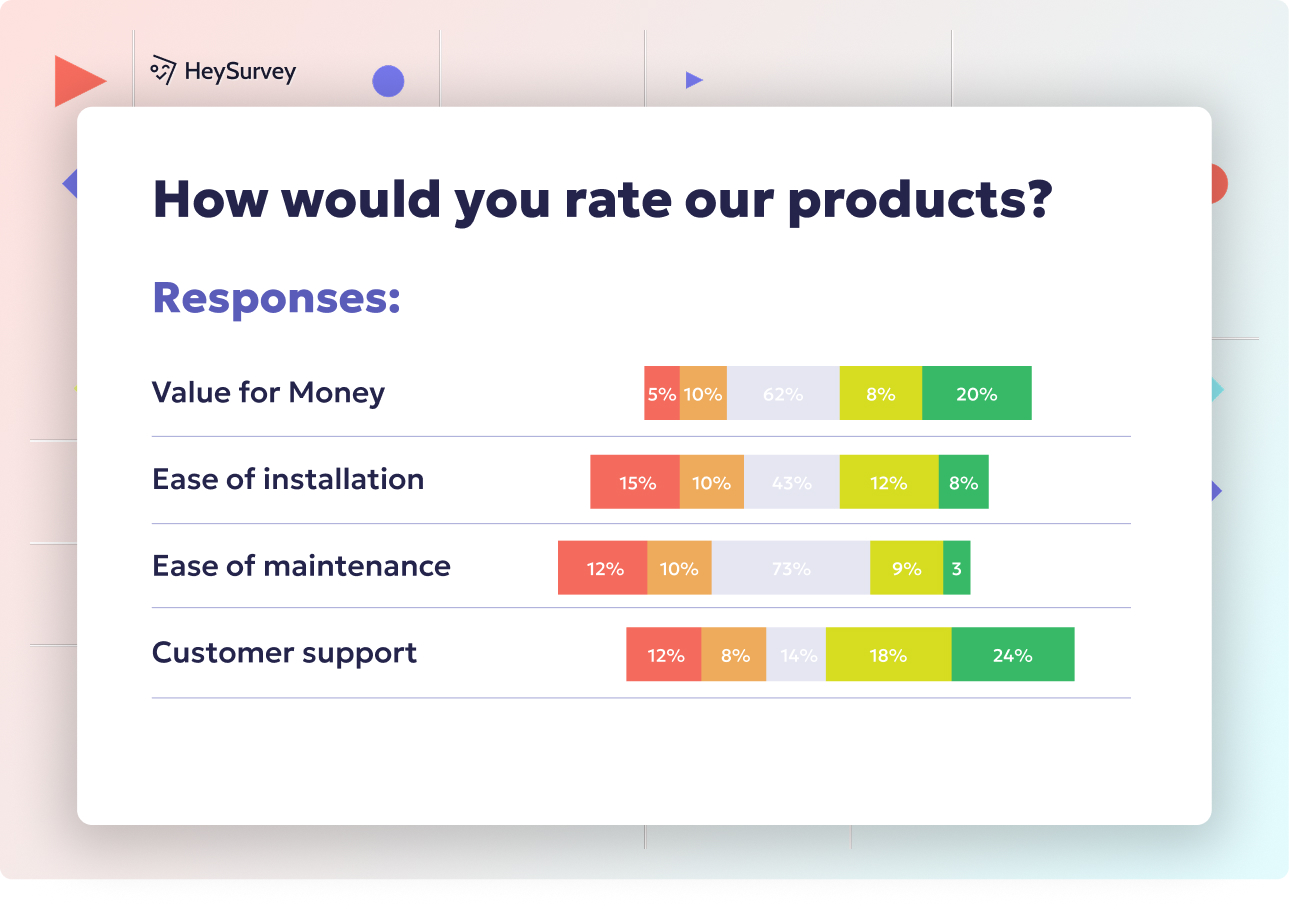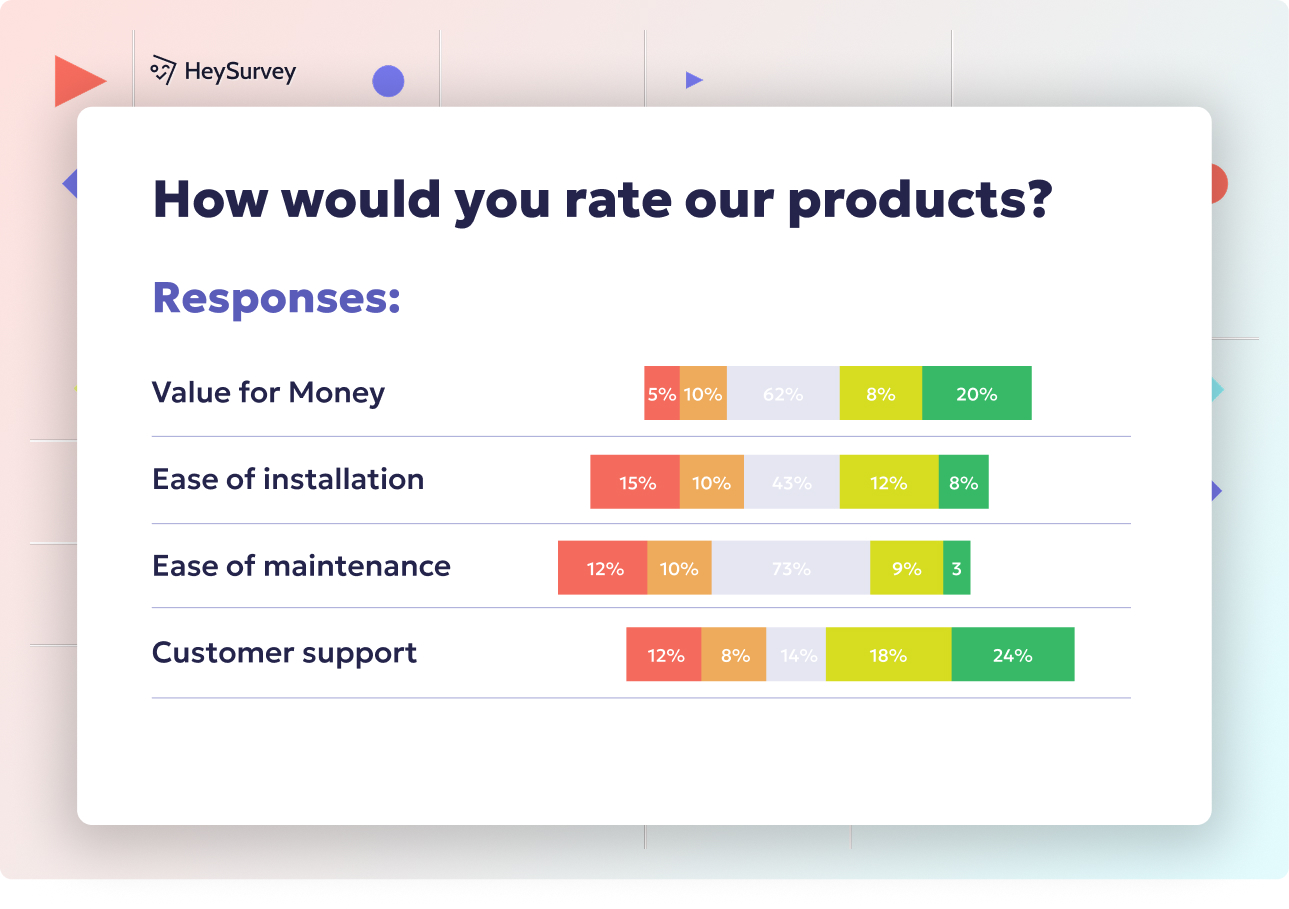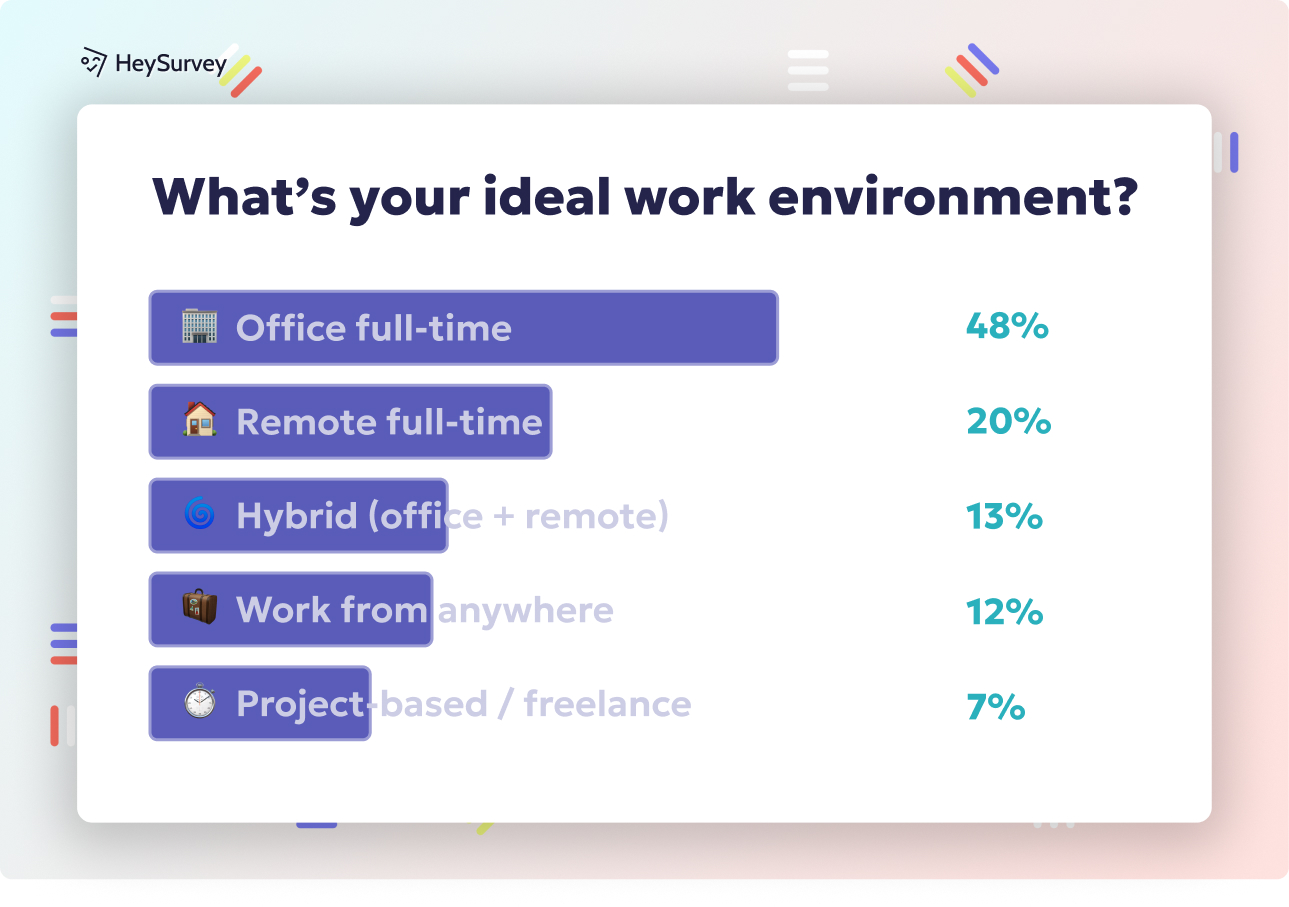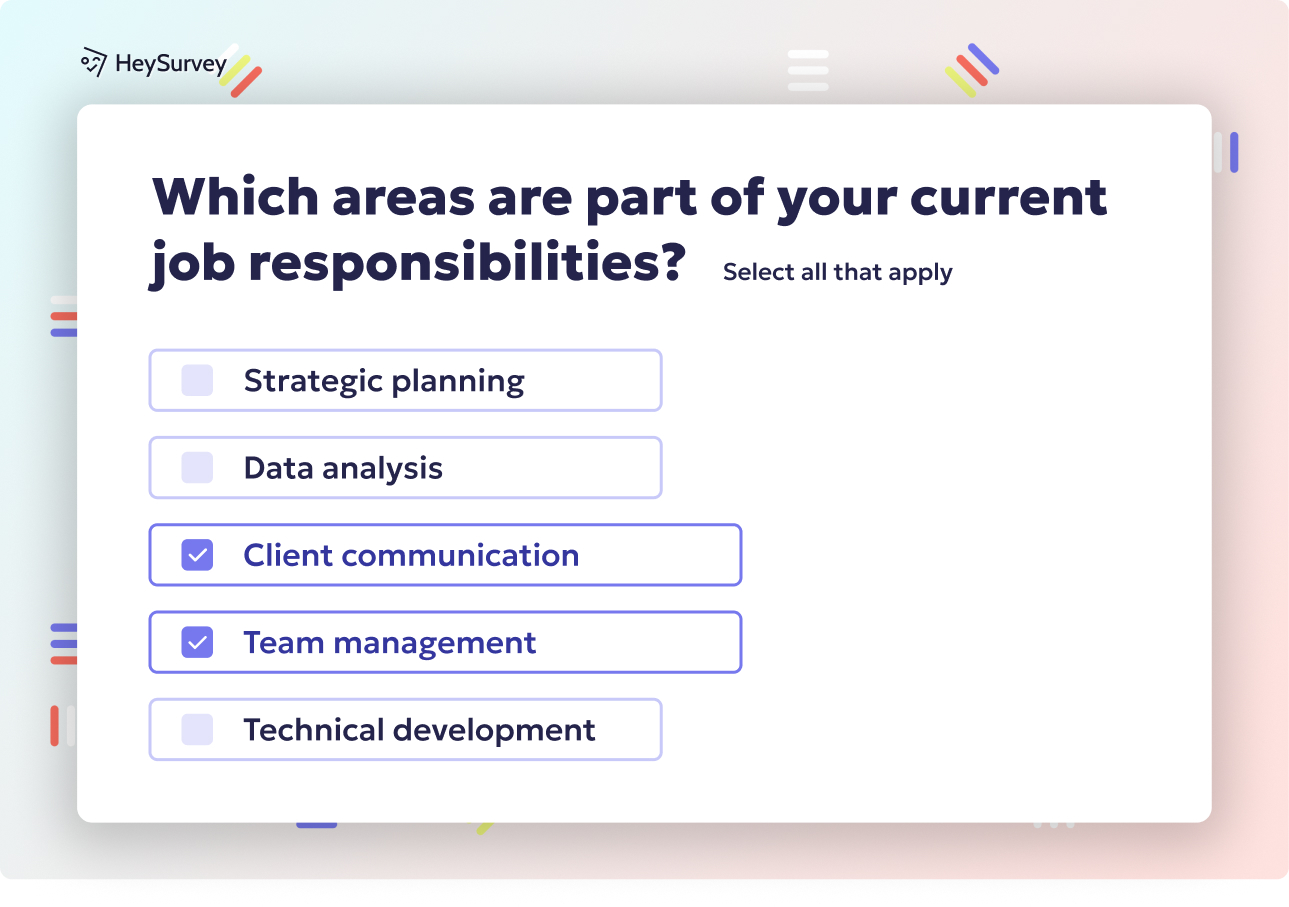31 Business Survey Questions: Types, Examples & Best Practices
Discover 30+ expert business survey questions with examples and best practices to unlock actionable insights across customers, employees, and markets.
Business surveys are secret weapons for organizations hungry for data-driven decisions. Strategically crafted survey questions unlock valuable insights into what truly matters across customer experiences, employee morale, market trends, and brand health. Not all questions are created equal: brilliant data starts by carefully aligning question types with business goals. Get this match right, and you’ll collect actionable feedback that boosts ROI, spots risks early, and reveals shiny new opportunities. Let’s explore how different business survey questions work, when to use them, and how to ask the right way for results you can trust.
Customer Satisfaction Surveys
What Are Customer Satisfaction (CSAT) Surveys?
Customer Satisfaction (CSAT) surveys are the pulse checks of the customer world. These tools ask just the right questions to gauge sentiment right after important touchpoints. Want to know if your support team nailed it or if your product wowed the buyer? CSAT surveys reveal if you’re making fans, losing interest, or just skimming by.
They provide simple measurements with huge potential for improving loyalty and advocacy. Happy customers stick around and spread the word. Unsatisfied ones? They quietly slip away—or worse, they warn others.
Why & When to Use CSAT Surveys
Using CSAT surveys is all about timing. Send them just after a purchase, onboarding, or support ticket closes—when the experience is still fresh. This allows for honest, accurate feedback and helps pinpoint exactly where to shine or improve.
Keep a close eye on loyalty trends with regular pulse checks, so you can:
- Identify and address service gaps right away
- Track the effectiveness of product and support teams
- Strengthen relationships at every touchpoint
Nothing keeps your customer journey honest quite like a well-timed CSAT survey. It’s the business equivalent of, “How’d I do?”
5 Sample CSAT Questions
How satisfied are you with your recent purchase experience?
Did our product/service meet your expectations today?
On a scale of 1–10, how likely are you to repurchase from us?
What was the primary reason for the score you gave?
What can we improve to serve you better next time?
Unfiltered answers to these questions pinpoint what delights customers and what needs fixing. Your roadmap for improvement—and increased retention—starts here.
Research indicates that while Customer Satisfaction (CSAT) surveys often yield overwhelmingly positive reviews from a small fraction of respondents, the majority of non-responding customers may have had less satisfactory experiences, highlighting a positivity bias in survey results. (arxiv.org)

Creating your survey with HeySurvey is a breeze, even if you’re a total newbie. Follow these 3 easy steps to get your survey up and running in no time. Plus, we’ve included some bonus tips to make your survey stand out and work smarter!
Step 1: Create a New Survey
- Head over to HeySurvey’s dashboard and click Create New Survey.
- Choose to start from scratch or pick a pre-built template that fits your survey type. (Templates save time and give you a polished head start!)
- Give your survey a catchy internal name so you can find it later easily.
If you want, just scroll down and hit the button below this guide to open a ready-made template for your survey type—no hassle, just click and customize.
Step 2: Add Questions
- Click the Add Question button at the top or in between existing questions.
- Select the question type that fits your needs: Multiple Choice, Scale, Text, etc.
- Type in your question and add helpful descriptions or instructions if needed.
- Mark questions as required if you want to make sure respondents don’t skip them.
- Feel free to add images or GIFs to make questions pop and engage your audience.
Remember, you can always drag questions around to reorder them or duplicate ones you like for faster setup!
Step 3: Publish Your Survey
- Preview your survey by clicking Preview—check that everything looks great on desktop and mobile.
- Once you’re happy, hit Publish. Note: You’ll need to create a free account to publish and gather responses.
- Copy your shareable link or grab the embed code if you want to place your survey right on your website.
- Send out the survey URL to your audience or include it in your email campaigns.
Bonus Steps to Make Your Survey Shine
Apply Branding
- Upload your logo to the survey header to keep your brand front and center.
- Use the Designer Sidebar to customize colors, fonts, backgrounds, and animation effects. Your survey can look exactly like your company’s style—no cookie-cutter vibes!
Define Settings
- Set start and end dates to control when your survey accepts responses.
- Limit the number of responses if you need to cap participation.
- Add a Redirect URL so respondents go to a thank-you page or next step after finishing.
- Enable options like letting respondents view the results for interactive feedback.
Skip Into Branches
- Use branching to customize which questions respondents see based on their previous answers.
- Create multiple endings with unique messages to make the survey experience feel tailored and thoughtful.
With HeySurvey’s intuitive interface and these easy steps, you’ll be collecting insights faster than you can say “response rate boost.” Ready to dive in? Hit that template button below and start creating your perfect survey now!
Employee Engagement Surveys
The Power of Employee Engagement Surveys
Employee engagement surveys are the fuel for a healthy, motivated workplace. They measure morale, reveal how aligned teams feel, and highlight any simmering retention risks before they boil over.
When employees feel seen and heard, productivity soars and the employer brand grows. These surveys tap into what keeps your workplace humming—and where you need to oil the gears.
Why & When to Use Employee Engagement Surveys
Don’t wait for the exit interview! Run these surveys quarterly, bi-annually, or right after big changes. This regular feedback keeps you connected to your culture’s heartbeat and allows for:
- Benchmarking the impact of new HR or culture initiatives
- Detecting early warning signs of disengagement or turnover risk
- Keeping communication open during times of uncertainty
Whether it’s post-reorg or just your spring check-in, timing matters for honest, current responses.
5 Sample Employee Engagement Questions
I feel valued for the work I do.
Do you see a clear path for career growth here?
How likely are you to recommend our company as a place to work?
What motivates you to perform at your best?
Which one thing would most improve your day-to-day experience?
With answers from these questions, leaders gain invaluable insight into team passion, pain points, and the path to stronger engagement.
Companies with engaged employees experience a 202% increase in revenue growth compared to those with disengaged employees. (wifitalents.com)
Market Research Surveys
Why Market Research Surveys Matter
Market research surveys are your business crystal ball. They help you peek into customer needs, validate demand, and spot where you fit in the competitive landscape.
Before you invest big in a new idea, these surveys catch trends and preferences that guide your strategy. They’re essential for knowing your audience and differentiating your offer.
Why & When to Use Market Research Surveys
Prepare and deploy market research surveys in the moments that matter:
- Before launching a new product or feature
- When planning to expand into fresh markets
- To test the waters with a new audience segment
Think of them as your risk-reduction buddies. They help avoid costly assumptions and discover what your next steps should actually be.
5 Sample Market Research Questions
Which of the following best describes your biggest challenge with [problem]?
How often do you purchase products in this category?
What factors most influence your buying decision?
Rank these brands in order of preference.
What price range would you consider reasonable for a solution like ours?
Responses will highlight customer pain points, competitor strength, and pricing sweet spots—data you need to stake your claim in the market.
Product Feedback Surveys
How Product Feedback Surveys Transform Your Offering
Product feedback surveys are the secret sauce for building better products. They empower users to shape the roadmap, informing what features to add, fix, or remove.
Actively listening reduces churn and keeps improvement cycles sharp. If you’re not asking the right questions, you’re just guessing.
Why & When to Use Product Feedback Surveys
Deploy product feedback surveys when:
- Rolling out a new feature or version
- After a user finishes a free trial
- Following a customer’s cancellation or churn event
The best time to seek this feedback is when the experience is fresh—not two months later when memories are fuzzy.
Gathering user insights at key stages prevents unwanted surprises and builds loyalty by making users feel valued and heard.
5 Sample Product Feedback Questions
Which feature do you find most valuable?
How easy was it to accomplish your goal today?
What feature is missing that would improve your experience?
Rate the overall performance of the product.
Compared with alternatives, how does our product stack up?
The answers will guide your upgrades, shine a light on hidden pain points, and showcase brand strengths—direct road signs toward product greatness.
Implementing product feedback surveys can lead to a 55% increase in customer satisfaction metrics. (moldstud.com)
Competitive Benchmark Surveys
Why Competitive Benchmarking Is a Game-Changer
Competitive benchmark surveys put you in your competitor’s customers’ shoes. They highlight your gaps, your wins, and where you need to adjust your message to break through.
It’s all about peeking over the fence—without breaking the rules—and seeing how your garden grows compared to theirs.
Why & When to Use Competitive Benchmark Surveys
Best deployed:
- During annual strategic reviews and audits
- After a buzzy new competitor launch
- To see if your latest features or pricing shifts have nudged market share
These surveys are critical tools for fine-tuning your positioning and understanding real-world perceptions—not just what your marketing hopes is happening.
5 Sample Competitive Benchmark Questions
Which brand do you currently use for [solution]?
What made you choose that brand over others?
Rate your satisfaction with your current provider.
Which additional features would make you switch providers?
How likely are you to consider our brand next time?
Use these responses to find out what you’re missing and what makes customers consider switching, then adjust your strategy accordingly.
Post-Event or Post-Training Surveys
Capturing Event or Training Success
Post-event or post-training surveys are the confetti at the end of a gathering. They let you know if your event or session hit the mark—or just the snooze button.
This feedback is critical for continuous improvement, measuring attendee satisfaction, and ensuring training translates to actual knowledge and ROI.
Why & When to Use Post-Event Surveys
Strike while the memory is fresh—send the survey within 24 to 48 hours after your event. This is when feedback is honest, actionable, and rich in detail.
Post-event surveys can help:
- Shape the content of future events or trainings
- Evaluate the event’s real value versus expectations
- Prove ROI to stakeholders and sponsors
One quick survey delivers priceless insights for your next big thing.
5 Sample Post-Event/Training Questions
How satisfied were you with the event’s overall value?
Which session delivered the most actionable insights?
Was the content level appropriate to your expertise?
How likely are you to attend future events we host?
What topics should we cover next time?
The feedback generated here is instrumental in fine-tuning future experiences and creating truly memorable events.
Brand Awareness Surveys
The Magic of Brand Awareness Surveys
Brand awareness surveys turn your hunches into hard data. They answer the big questions: Do people know your brand? Do they remember you? Is their impression good, bad, or just “meh”?
This feedback goes beyond ego—it drives smarter marketing spend and clarifies your real position in the market.
Why & When to Use Brand Awareness Surveys
Leverage these surveys:
- Before and after big ad campaigns, rebrands, or major PR moves
- To evaluate how messaging and creative changes impact perception
- During annual brand audits for ongoing improvement
Campaigns without measurement are like parties without RSVP lists—you never really know who’s engaged and who just read the invite.
5 Sample Brand Awareness Questions
Which brands come to mind when you think of [category]?
Have you heard of [Your Brand] before today?
How would you describe our brand in one word?
Where have you seen or heard about our brand recently?
How favorably do you view our brand compared to competitors?
The answers will guide brand positioning, messaging strategy, and budget allocation for maximum impact.
Best Practices: Dos and Don’ts for Crafting High-Impact Business Survey Questions
Crafting Questions for Crystal-Clear Insights
The difference between a forgettable survey and an insight goldmine lies in the details. Nailing the fundamentals—clarity, brevity, and objectivity—ensures high-quality, actionable data.
Here’s how to make your next survey both irresistible and reliable:
- Clarity counts: Simple words and direct questions win every time. Ditch jargon and industry slang.
- Neutrality is key: Ask unbiased questions for honest answers. Avoid leading language or subtle hints at “right” answers.
- Stick to one topic per question: Double-barreled questions muddy the waters. One thought, one answer.
- Keep surveys bite-sized: Respect their time. Shorter surveys boost completion rates, while four-page epics just disappear into the ether.
- Mobile-first matters: Make sure surveys work on every device, especially for on-the-go respondents.
- Incentives are for fun, not pressure: Reward participation ethically, not manipulatively.
- Pilot test before launch: Catch weird wording or logic errors before your whole audience does.
- Honor data privacy: Be upfront about anonymity, data use, and security. Trust is precious—protect it.
Here’s your cheat sheet for best practices for business survey questions:
Dos: - Use crisp, conversational language
Offer balanced response options (e.g., positive, neutral, negative)
Test surveys with a small group first
Limit to 10–12 questions whenever possible
Be transparent about survey purpose and length
Say “thank you” for participation—gratitude matters
Don’ts: - Don’t overload with complex rating scales
Don’t use double negatives or confusing phrasing
Don’t ask for sensitive info without a clear reason
Don’t hide how responses will be used
Don’t spam with endless reminders
Don’t ignore mobile users or accessibility needs
The secret to high-impact surveys is asking just enough of the right questions—clear, focused, and always relevant to your business goal.
Now you’re ready to create surveys that don’t just collect data—they inspire action, spotlight trends, and build loyalty across every business domain. Start asking, start learning, and let the insights roll in!
Related Business Survey Surveys

27 Tips to Tackle Nonresponse vs Voluntary Response Bias
Explore nonresponse vs voluntary response bias with 30 sample survey questions to improve survey ...

29 Essential SWOT Survey Questions for Strategic Insights
Discover 25+ expert SWOT survey questions designed to capture strengths, weaknesses, opportunitie...

25 Quality Assurance Survey Questions for Best Results
Elevate your approach with 25 sample "quality assurance survey questions" and best practices to s...

